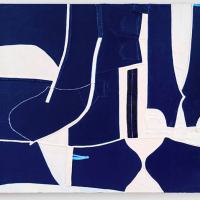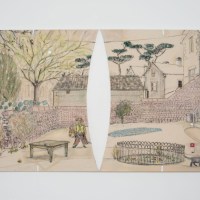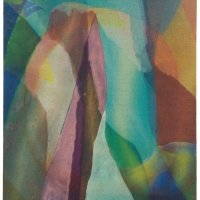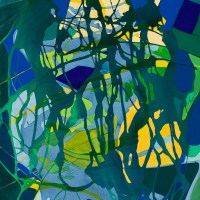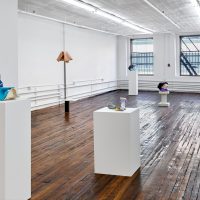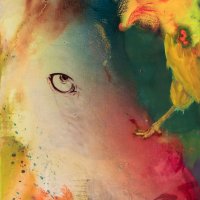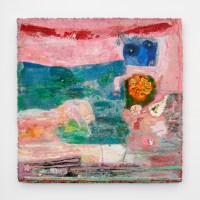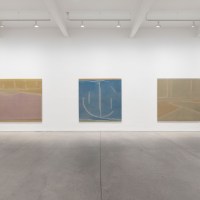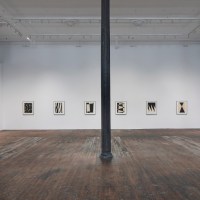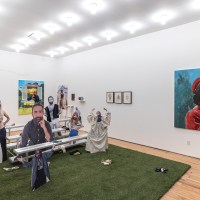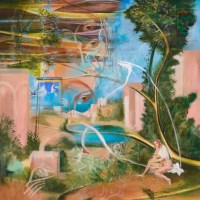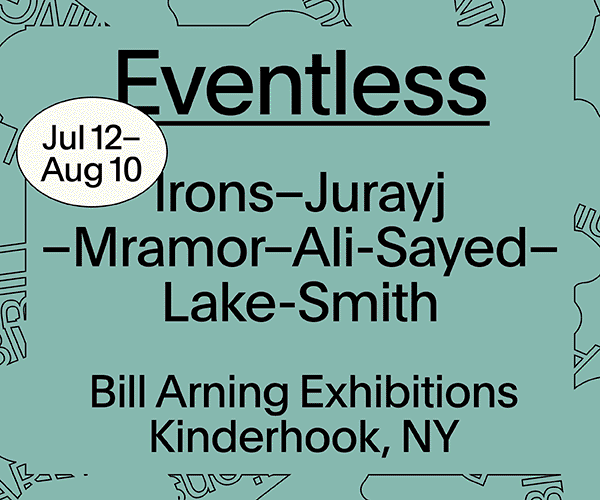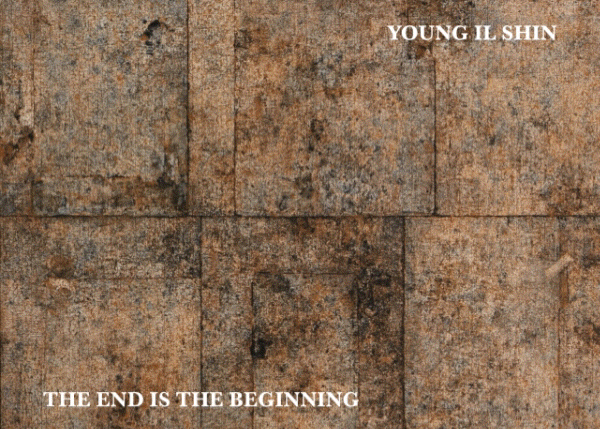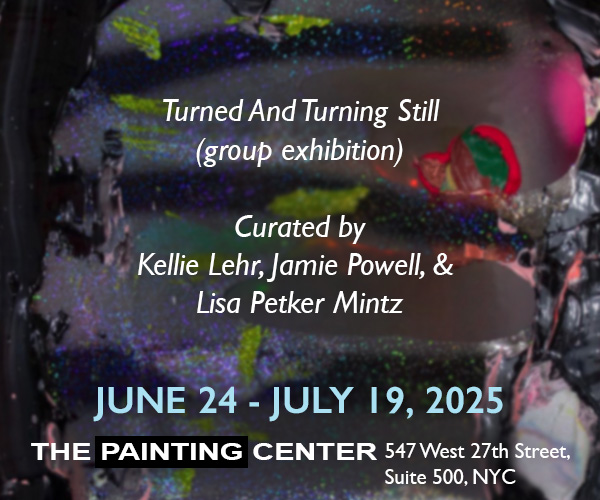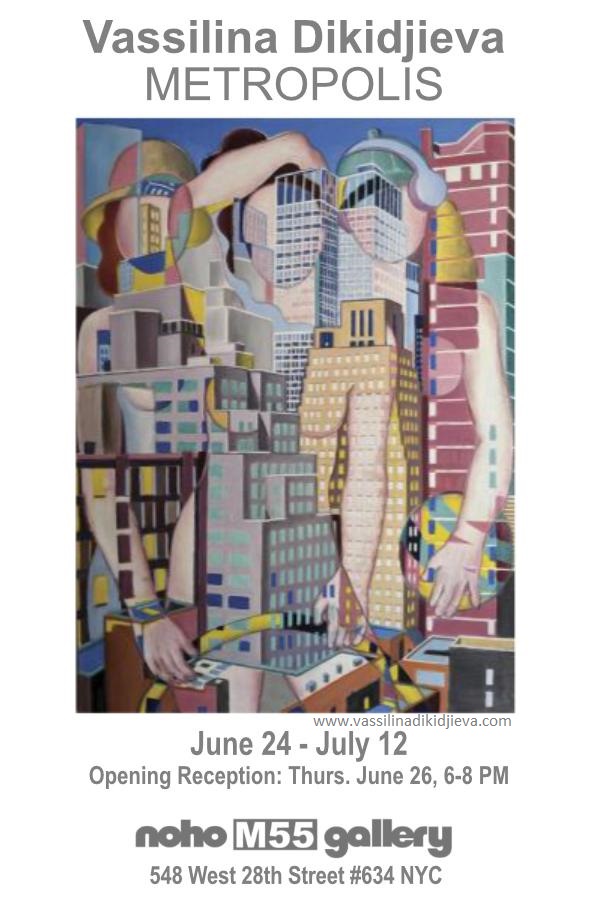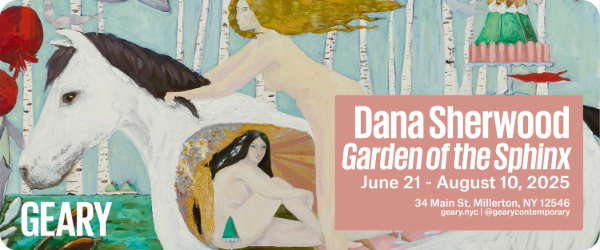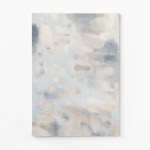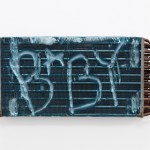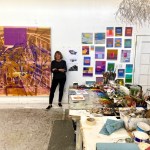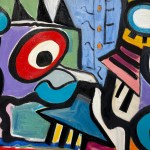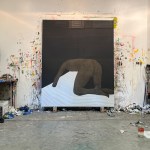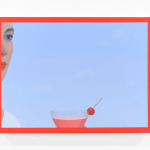Contributed by Theodora Bocanegra Lang / Nearly half the paintings included in Kaiadilt artist Mirdidingkingathi Juwarnda Sally Gabori’s first solo show in New York, at Karma in Chelsea, are titled My Country. A few more are called My Father’s Country, and a few others Dibirdibi Country. Though her works are firmly abstract, it is impossible not to think of landscapes and location when viewing them. The artist, whose name is sometimes shortened to Sally Gabori, was born in 1924 on Bentinck Island in Australia, the ancestral homeland of the Kaiadilt people. In 1948, missionaries forcibly displaced Gabori and her people to nearby Mornington Island, where she lived for the rest of her life. She began painting in 2005, when she was about 81, and died a decade later in 2015. While she had not lived on Bentinck Island for nearly 60 years, her work reflects sharp yearning for, and irreparable separation from, her home.
Solo Shows
Medrie MacPhee: Upcycling
Contributed by Adam Simon / The five abstract paintings in Medrie MacPhee’s “The Repair,” at Tibor de Nagy, have just enough indications of figure/ground and observed reality to evoke landscape, interior space, aerial view, blueprint. What also connects these paintings to the physical world, as we perceive it, are minor shifts of line, contour, or color that activate the surface and keep the paintings from being flat. While the paintings are large, all but one measuring 64 x 84 inches, somehow the small gallery doesn’t feel crowded.
Merlin James and the thinking of painting
Contributed by Sharon Horvath / Prominent critics have written extensively about the paintings of Merlin James, and James himself is an erudite art writer. Still, I am compelled to explore how it is that his painterly magic works on my mind. As I walked through the two rooms of his current show “Hobby Horse” at Sikkema Malloy Jenkins, the paintings struck a chord, bringing up half remembered lines of Wallace Stevens’ poetry, plucked out of context.
Nancy Evans: Cosmic absorption
Contributed by Mary Jones / One of many pleasures in “Mashups,” Nancy Evans’s show at Sargent’s Daughters, is the sensation of immersive color. Eight abstract paintings, all 26 x 20 inches, reverberate softly with veils of translucent gradients and undulating organic form. The work is grounded in American Modernism, and a baseline of particular influences come to mind: Arthur Dove, Georgia O’Keefe, Charles Burchfield, and, as a watercolorist, Helen Frankenthaler. But Evans finds her own domain through a mediated technical process that generates luminous depth.
Gerri Rachins’ raptorial abstractions
Contributed by Jonathan Stevenson / While some art pulls you in gently, Gerri Rachins’ paintings, now on display at The Painting Center, grab you like a raptor. Though unequivocally abstract, their affect, as it were, is prehensile. They seem to guard the walls, flexing with taut line and pulsing color, at once opaque and fluid.
Ross Knight: Sculpting in the material world
Contributed by Millree Hughes / With precisely targeted color, texture, and feel, Ross Knight’s sculptures in his solo show “Continuous Squeeze” at Off Paradise get at what physical artifacts mean in terms of our fears, fantasies, and daily struggles. Color is critical in Knight’s work. He keeps the palette small and specific, the colors he chooses leaning towards youthful nostalgia: the baby-blue of 1960s cars in Coupled Prop, a buoy yellow with custard drips in another Coupled Prop, the creamy hue of a rawhide dog chew-toy in Device. The band in Adjusted resembles an old, spent balloon, once yellow-orange but turned raw sienna with time. Does anyone ever get over a popped balloon? It’s a toddler’s tragedy. The fleshy knots, like umbilical cord buttons, are rendered useless.
Barbara Friedman’s exquisite grotesquery
Contributed by Adam Simon / The modus operandi behind much of Barbara Friedman’s work, including her current exhibition “All Rude and Lumpy Matter” at Frosch & Co., has a name, pareidolia, which refers to finding images within abstraction. Think of the age-old pastime of finding faces in clouds.
Daisy Sheff: The anatomy of fairy tales
Contributed by Jason Andrew / Daisy Sheff’s exhibition “Begun in the Dazzling Sunshine” at Parker Gallery’s new space on Melrose in Los Angeles, intertwines reality with the fantastical. Her paintings employ leaping animals, fussy architectures, and bright flora to explain narratives that tease the peculiar logic of fairy tales. Their uneven surfaces, cleverly devised characters, and woolly layered scenes are busy and unwieldy. To interpret them is like piecing together the plot of a really great dream.
Jilaine Jones’s unfolding curiosity
Contributed by David Whelan / If I asked you to make a sculpture about walking through the woods, what would you make? How would you go about expressing an awareness of your body in relation to the dense forest – stepping over downed logs, ducking under branches, feeling your feet against the ground and the sun warm on your skin? In A Walk with D. Ann at 15 Orient, Jilaine Jones suggests that we aren’t just walking through woods but having the experience of being human. There is an emphasis on gravity and things returning to the ground throughout the show. Landscape and motion, forms and space, combine to build emotional weight in the sculptures, asserting a presence while keeping their origins just out of grasp.
Julie Beaufils: New painting for end times
Contributed by Jason Andrew / It’s easy to associate the new paintings by Julie Beaufils, now on view at Matthew Brown Gallery in Tribeca, with a post-apocalyptic world. The sixteen paintings suggest fractured architectures and abandoned fields, sun baked and rising from a humming radioactive haze. Beaufils lives and works in Paris, and her precise lines and delineated spaces capture its curving promenades, narrowed boulevards, and sinking perspectives. Travels to Los Angeles and the American Southwest have also influenced this new work.
Force field: Myron Stout’s drawings
Contributed by Natasha Sweeten / In the early 2000s, among the pines and solace of an artist residency, Polly Apfelbaum shared with me a small, well-thumbed through book. Right off the bat I took the isolated black-and-white image on its cover to possess talismanic powers. Such was my introduction to the work of Myron Stout.
Aaron Michael Skolnick: How heartbreakingly silly we are
Contributed by Nancy Friedland / I don’t remember exactly when I first came across the work of Aaron Michael Skolnick, but I do remember the feeling. Confronted by landscapes so filled with love and loss, I wondered how a painting of light in a forest could express so much. When the gorgeous images from his most recent project – face mash-ups of Aaron and famous, sometimes funny, often tragic characters – started to pop up in my feed, I needed to know more. I searched to see what was out there about Aaron’s show “The Entertainer,” currently up at MARCH Gallery in the East Village, and found nothing to satisfy my curiosity. As I began to dig into the work myself, I quickly realized that it had tentacles that wrapped around every aspect of the artist’s life. There were the paintings, yes, beautifully wrought, deftly painted, of course, but there was also an installation, photography, and performance. The work was so layered and complex that I felt the need to reach out directly to Aaron to ask him what it was all about. Last week, I picked up the phone and tried to uncoil some of those tentacles and make sense of a complex, brave, and very funny new body of work.
Fergus Feehily: The Horse and The Rider
Contributed by Joe Fyfe / Fergus Feehily, who is from Ireland but has lived in Berlin for years, is an unusual contemporary visual artist by virtue of his very careful degree of quiet obliquity. One almost hesitates to approach writing about him and, in this case, writing about his writing. It might be best to get the disclaimers over with: we share gallery representation in Köln, from Galerie Christian Lethert. He recommended me to the gallery, though at the time, long ago, I had never heard of him nor his work. I have since met him a few times. Once we had breakfast at Balthazar in New York and I remember how thoroughly he buttered and spread preserves on two sizable croissants. Feehily is somehow obscure but in plain sight, admired among an informed coterie of artists and collectors and an avid sharer. He does a lot of communicating. He posts on Instagram often, mostly very different kinds of artworks, though he appears to have something of a penchant for religious art. On his website are long year-end lists, an annī of enthusiasms for what he has read and listened to and looked at, whom he has met and spoken with.
Donna Moylan’s egalitarian eclecticism
Contributed by Elizabeth Johnson / “Recent Paintings,” Donna Moylan’s first exhibition at Bookstein Projects, collects works finished over the last year in her Kinderhook studio. In our email conversation, Moylan said that “sometimes paintings take years, as if they had to go off and think.” In addition to making paintings that carry time in the process of their production, she forgoes committing to a serial style, allowing her paintings to differ drastically from one to the next. “When I started doing that, in the nineteen-eighties,” she wrote, “I understood that what I wanted was to equalize, or make equivalent, many different styles of painting, and to refer to different cultures or eras with specificity but without differentiation or emphasis, without focusing on ‘styles.’” She has achieved this goal with considerable aplomb.
Andrew Mer: All things obscure and oblique
Contributed by Amanda Church / What do we not see every day even when we are looking? Andrew Mer, aka @bigfusss on Instagram (where these photographs were first discovered), considers the question in his current show “Agog” – the filmmaker’s first exhibition of photography since moving to New York 30 years ago – at Mitchell Algus Gallery. The show consists of thirty 14 x 11-inch digital prints, shot on an iPhone starting in 2020, in editions of five with two artist’s proofs. The spontaneous photos of street scenes are in one sense classic Instagram moments, evanescent and transient. At the same time, they capture the so-easy-to-overlook minutiae of urban existence in precise compositions.


